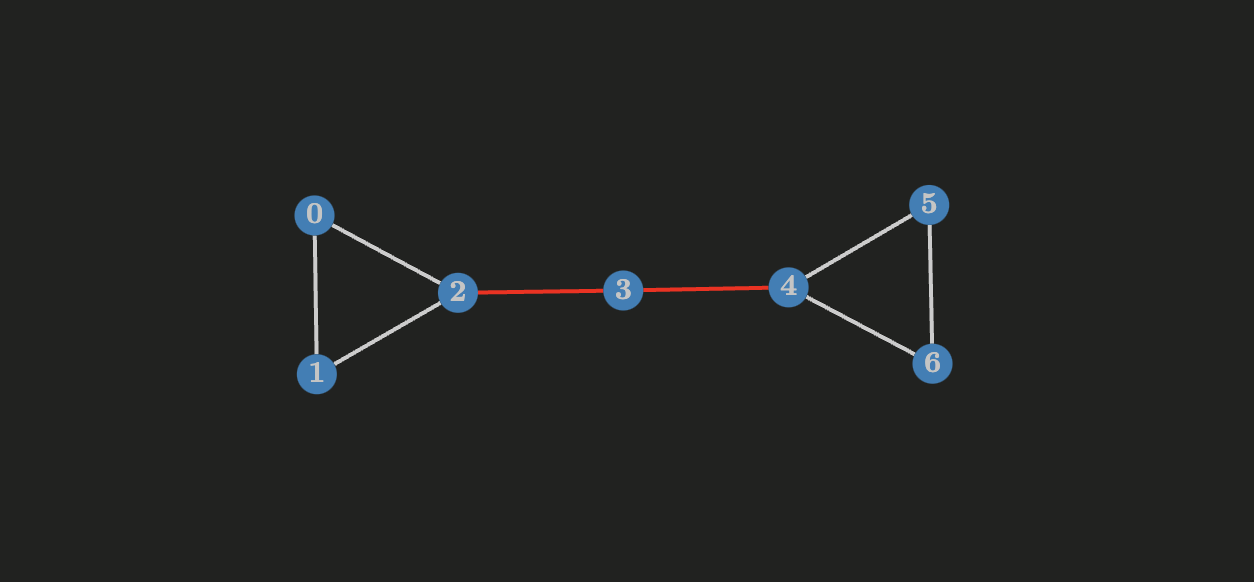Undirected graph
In the following undirected graph $G$ the edges $v_2v_3$ and $v_3v_4$ are bridges
- An edge $e$ of an undirected graph $G$ is a bridge if and only if $e$ lies on no cycle of $G$
- Every edge of an undirected tree is a bridge
Let $G$ be an undirected graph, by analyzing the properties of the dfs tree we can determine if an edge is a bridge given the following facts:
- let $u$ and $v$ be two vertices of the dfs such that $u$ is an antecesor of $v$, also $u$ and $v$ are not adjacent
- if there’s a back edge $vu$ then none of the edges in the $u-v$ path are bridges, if we remove one of them the graph is still connected because of this edge
- otherwise the edge is a bridge
Implementation notes
- to check if a succesor of a vertex $u$ has a back edge to a predecessor of $u$ an additional state is stored in each vertex which is the discovery time of the lowest back edge of a successor of $u$ (by lowest back edge we mean the back edge to a vertex with the lowest discovery time) denoted as $u_{back}$, initially this state is set to the discovery time of the vertex $v$ i.e. $u_{back} = u_{in}$, this state is propagated when the backtracking is performed
- let $uv$ be a back edge, when this edge is analyzed the $v_{back}$ state needs to be updated to be the minimum between the existing $v_{back}$ and the discovery time of $u$, i.e. $v_{back} = min(v_{back}, u_{in})$
- let $v$ be an adjacent successor of $u$ in the dfs tree, when we’ve finished analyzing the branch of the tree because of the $uv$ edge we have to check if the $v_{back}$ state contains a back edge to some predecessor of $u$ ($v_{back}$ is propagated) i.e. $u_{in} > v_{back}$, if so then $uv$ is not a bridge
int time_spent;
// the adjacency list representation of `G`
vector<vector<int> > g;
// the time a vertex `i` was discovered first
vector<int> time_in;
// stores the discovery time of the lowest predecessor that vertex `i`'s
// succesor vertices can reach **through a back edge**, initially
// the lowest predecessor is set to the vertex itself
vector<int> back;
// the bridges found during the dfs
vector<pair<int, int> > cut_edge;
void dfs(int v, int parent) {
// the lowest back edge discovery time of `v` is
// set to the discovery time of `v` initally
back[v] = time_in[v] = ++time_spent;
for (int i = 0; i < g[v].size(); i += 1) {
int next = g[v][i];
if (next == parent) {
continue;
}
if (time_in[next] == -1) {
dfs(next, v);
// if there's a back edge between a descendant of `next` and
// a predecessor of `v` then `next` will have a lower back edge discovery time
// otherwise it's a bridge
if (back[next] > time_in[v]) {
cut_edge.push_back(pair<int, int> (v, next));
}
// propagation of the lowest back edge discovery time
back[v] = min(back[v], back[next]);
} else {
// *back edge*
// update the lowest back edge discovery time of `v`
back[v] = min(back[v], time_in[next]);
}
}
}
/**
* Finds the bridges in an undirected graph `G` of order `n` and size `m`
*
* Time complexity: O(n + m)
* Space complexity: O(n)
*/
void bridges() {
int n = g.size();
time_spent = 0;
time_in.assign(n, -1);
back.assign(n, -1);
cut_edge.clear();
for (int i = 0; i < n; i += 1) {
if (time_in[i] == -1) {
dfs(i, -1);
}
}
}
Directed graph (strong bridges)
Let $G$ be a directed graph, an edge $uv \in E(G)$ is a strong bridge if its removal increases the number of stronly connected components of $G$
The following is a connected graph $G$, every edge but $v_2v_0$ is a strong bridge because removing it from $G$ increases the number of strongly connected components, removing $v_2v_0$ doesn’t increase the number of strongly connected components so it’s not a bridge
A trivial algorithm to find the strong bridges of a digraph $G$ of order $n$ and size $m$ is as follows:
- Compute the number of strongly connected componentes of $G$ denoted as $k(G)$
- For each edge $e \in E(G)$
- remove $e$ from $G$
- compute the number of strongly connected components of $G$ denoted as $k(G - e)$
- if $k(G) < k(G - e)$ then $e$ is a bridge
The time complexity of the algorithm above is clearly $O(m(n + m))$
Let $uv$ be an edge of a digraph $G$, we say that $uv$ is redundant if there’s an alternative path from vertex $u$ to vertex $v$ avoiding $uv$, otherwise we say that $uv$ is not redundant, computing the strong bridges is equivalent to compute the non-redundant edges of a graph
http://www.sofsem.cz/sofsem12/files/presentations/Thursday/GiuseppeItaliano.pdf

